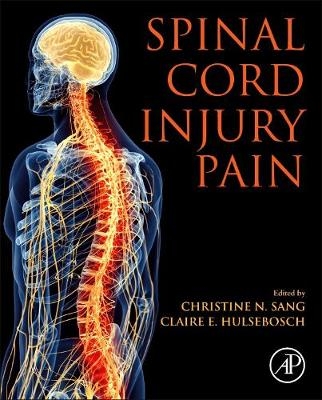
Spinal Cord Injury Pain
Academic Press Inc (Verlag)
978-0-12-818662-6 (ISBN)
Despite a better understanding of the complexity of mechanisms of CNP/SCI, improved medical and surgical management of SCI, and the subsequent acceleration of the identification of new targets and the development of novel analgesics, there is still a great unmet clinical need in the area of CNP following SCI. Hence, this book is a welcomed addition to current research and developments.
Christine Sang, MD, MPH is Associate Professor of Anaesthesia at Harvard Medical School. Dr. Sang served as Associate Medical Director of the Pain Research Clinic at the NIH, Director of the Clinical Trials Program at the Massachusetts General Hospital Pain Center, and is currently the Director of the Translational Pain Research Program at the Brigham and Women's Hospital (BWH). She has served on several committees including the American Pain Society (as director-at-large), American Society of Anesthesiologists (as a member of the chronic pain analgesic guidelines committee), American College of Occupational and Environmental Medicine (as a member of the chronic pain practice guidelines committee), the National Spinal Cord Injury Association/United Spinal Association (as founding chairman of its Medical and Scientific Advisory Committee), North American Clinical Trial Network Neurological Outcomes Assessment Task Force, the Rick Hansen Institute (as director), the Healthcare Institute for National Renewal and Innovation (director), and several local advisory committees including the NIH-funded Harvard University Catalyst, the BWH Clinical Investigation Advisory Committee, the BWH Translational Accelerator Advisory Committee, and the BWH Research Management Task Force. Dr. Sang has specific expertise in the development of innovative clinical trial strategies to accelerate the clinical development of novel analgesics. These include new clinical trial methodologies (in Phase 1a/First-in-Human through to Phase 2a clinical trials) and the discovery of potential clinical biomarkers to to target selective mechanisms of pain by optimizing efficient designs, endpoints (including biomarkers), and execution. Claire E. Hulsebosch, Ph.D. is Professor, Department of Neurobiology and Anatomy, McGovern Medical School, The University of Texas Health Science Center at Houston. She pioneered the concept of nerve cell process reorganization and the formation of new nerve connections (synaptogenesis) in the spinal cord after injury, which formed the basis for the subsequent hypotheses involving spinal cord reorganization resulting in central neuropathic pain. She has numerous publications that demonstrate the ability of nerve cells to reorganize after spinal cord injury. In addition, she has several publications examining the ability of nerve fibers to reorganize after brain injury and stroke. Currently, Dr. Hulsebosch is part of the scientific advisory board for both the Neurological Recovery Network and the North American Clinical Trials Network, which are actively involved in advancing clinical trials in spinal cord injury. She serves as scientific advisor to the National Institute of Health for Neuroscience Initiatives, on study section for National Institute of Neurological Diseases and Stroke, on the Craig Neilsen Foundation, the Christopher and Dana Reeves Foundation, the New Jersey Commission for Spinal Cord Injury Research, The Kentucky Initiative for Brain and Spinal Cord Injury Research, The New York Commission for Spinal Cord injury Research and a variety of editorial and review boards for scientific journals. She was a founder and served as Director of Mission Connect, a multi-institutional research group whose mission is to advance research for recovery after brain and spinal cord injury, from 2005 to 2008.
Part I: Approaches to the development of new technologies
1. Electrophysiological phenotyping of neuropathic pain following spinal cord injury 2. Spinal cord injury pain: A retrospective 3. Central neuropathic pain after spinal cord injury: Therapeutic opportunities. A brief history and temporal progression of the pathophysiology from acute trauma to chronic conditions 4. Mechanisms of pain below the level of spinal cord injury (SCI) 5. Devil’s advocate: Why past and future animal models of neuropathic pain in spinal cord injury are without merit 6. Counterpoint: Why animal models are indispensable for translational pain research in spinal cord injury 7. Behavioral assays of pain in rodent models of spinal cord injury 8. Biomarker signatures for neuropathic pain after SCI 9. Decoding nociception in the spinal cord: Computer modeling and machine learning 10. EEG biomarkers of pain and applications of machine learning 11. Perspectives on preclinical evidence for translation in SCI 12. Screening and treatment of neuropathic pain after SCI
Part II: Mechanisms of CNP following SCI Section 1: Spinal and supraspinal mechanisms 13. Spinal GABA mechanism in neuropathic pain after spinal cord injury 14. Glial activation and neuropathic pain 15. Mechanisms of CNP following SCI: Chemokines in neuronal-glial cell interaction
Section 2: Peripheral mechanisms 16. When soft touch hurts: How hugs become painful after spinal cord injury 17. Peripheral mechanisms contributing to central neuropathic pain following SCI
Section 3: Clinical applications of novel targets and technologies 18. Human neural stem cell transplantation for improved recovery after spinal cord injury 19. Cell transplantation for reducing neuropathic pain after SCI 20. Gene therapy of neuropathic pain after spinal cord injury 21. Exercise as a therapeutic intervention for neuropathic pain after spinal cord injury
| Erscheinungsdatum | 29.10.2021 |
|---|---|
| Zusatzinfo | Approx. 100 illustrations (100 in full color); Illustrations |
| Verlagsort | San Diego |
| Sprache | englisch |
| Maße | 191 x 235 mm |
| Gewicht | 1200 g |
| Themenwelt | Medizinische Fachgebiete ► Chirurgie ► Neurochirurgie |
| Naturwissenschaften ► Biologie ► Humanbiologie | |
| Naturwissenschaften ► Biologie ► Zoologie | |
| ISBN-10 | 0-12-818662-3 / 0128186623 |
| ISBN-13 | 978-0-12-818662-6 / 9780128186626 |
| Zustand | Neuware |
| Informationen gemäß Produktsicherheitsverordnung (GPSR) | |
| Haben Sie eine Frage zum Produkt? |
aus dem Bereich


